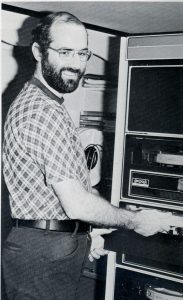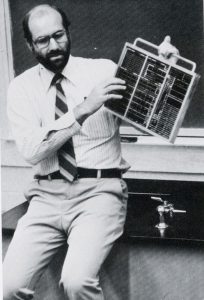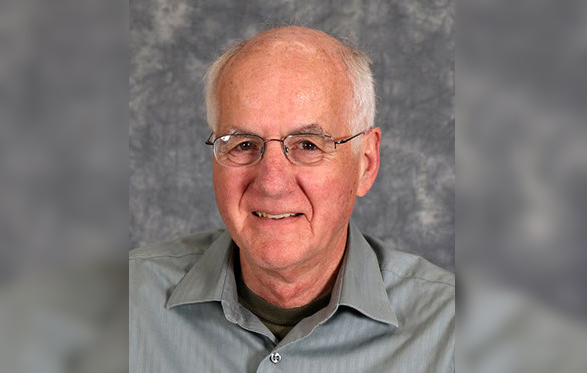“If there was ever a question about what happened in the early days of technology at Eastern Mennonite University, the go-to person was understood by everyone to be Joe Mast,” says Jack Rutt ‘72, special projects support for the provost’s office and former information systems director from 1999-2014. “It was understood almost ubiquitously that ‘Joe would know.’”
For years, Professor Joe Mast was the forefront of technology at EMU. You’re not misreading that last sentence. Mast was not at the forefront; he was the forefront.
Mast graduated from EMC in 1964 with a degree in mathematics. Following graduation, he taught math and physics at Eastern Mennonite High School before enrolling at the University of Virginia in astronomy.
Mast’s research for his dissertation, conducted at the National Radio Astronomy Observatory in Greenbank, West Virginia, explored the motion and distribution of interstellar hydrogen clouds near the sun. It was during those studies that he was introduced to the new field of computer science.

In 1968, Mast returned to EMC to join the new department of physics with fellow professors Robert Lehman and John Horst (some of the information in this article comes from an article that John Horst wrote for Integram, the mathematics department newsletter, upon his colleague’s retirement).
That same year, the first computer arrived on campus: The IBM 1130, which took up its own room in the new Suter Science Center, quickly captivated Mast. The next year (fall of 1969), he started teaching “NatSci 151 Programming Computers” (in Fortran).
He used the machine to grade tests for professors in all departments – using a punch card system that, he jokes, indicated answers in a similar manner to “the hanging chads in the 2000 election.”
Mast started using email in the ‘70s, when addresses were comprised of two numbers (“375,75,” he easily remembers years later.)
Around this time, he also used a teletype, or electromechanical typewriter, to communicate with professors at UVa.
In those early days, Mast says modem connections allowed data transfers at 300 characters per second (2400 bits/sec). To put that in perspective, “If you’re going to send a picture [today], that would be a million characters … now we send things at billions of characters per second.”
Mast taught programming through the ‘70s, complimenting his autodidactic nature with coursework at then-Madison College across town.

Notably, he didn’t have a formal degree in computer science until 1986, when he earned a Master’s of Computer Science at University of Virginia. This was several years after he gained approval, in 1979, to introduce a two-year computer science degree, and in 1981, a four-year degree.
The field was so new at the time that many academics, with tentacular knowledge that spreads across linked fields, could tell similar stories about the genesis of computer science programs at colleges and universities around the country.
John Horst writes appreciatively of his colleague’s eclectic knowledge and teaching responsibilities: “The span of Joe’s teaching responsibilities through the 1970’s and early 80’s, was remarkable: teaching courses in astronomy, courses in the physics major, courses in the math major, courses in computer science, helping with planetarium programs, and on occasion teaching in the interdisciplinary humanities program!”
With such knowledge naturally came the task of developing and supervising technological acquisitions. Mast served as Academic Computer Center Coordinator from 1980-85, during which time an Apple IIe word processing lab was installed (1983) and the first laser printer arrived (1987).
He also opened an Apple store for students, until the company took control of all sales.
In the mid-‘80s, Mast also taught courses in the Information Systems major developed by the Business Department.
In 1993, Mast wrote and submitted a National Science Foundation grant that resulted, the next year, in the internet’s arrival to campus. (NSF managed non-military Internet connections from the early ‘90s through 1998.)

“The internet is like a great big tree, so our connection went directly to James Madison, which went maybe to the University of Virginia,” Mast explained. “We were glad to have it funded.”
In fall 1994, Dan Marple was hired to head the new Information Systems Department, while Mast was on sabbatical at UVa.
In his 38 years at EMU, Mast also taught physics, mathematics and astronomy classes (45 different courses total), as well as directing the M.T. Brackbill Planetarium.
Mast now lives in Lancaster, Pa. He was married exactly 50 years to Nancy Noll ’67 Mast, who retired after 30 years as a teacher and administrator in the Rockingham County Public School. Nancy died in 2015. He has two married sons: Brian, a nuclear engineer with Peach Bottom Atomic Power Station, and Darrell, a computer specialist at Data Computer Corporation of America in the department that handles the Medicaid program for the US government.

I took physics under Joe at EMHS in 1964. In 1968 I was a history major at EMC but I signed up for a course in Astro-physics under Joe so that I could get access to the new computer. I remember beating it at three dimensional tic-tac-toe. We used it to solve two body problems. Joe would talk about the new credit union in Park View that he was instrumental in starting. I think it succeeded.
I do remember the 3D tic-tac-toe game the computer played an aggressive offensive game. I first won a game after Robert Lehman’s daughter came in one evening and I set her up and she beat it. After she left I played until I won.
Pleasure and honor to have taken C++, Visual Basics and AI with Joe at EMU.
Was an Honor to learn C++, Visual Basics and Artificial Intelligence under Joe Mast at EMU..
Kingsley Okoli
EMU 2004
Joe was instrumental in helping me to get started on a long software development career. I was a computer science major in the 80’s, learning Pascal and C, on IBM desktop computers where everything was copied to floppy disks.